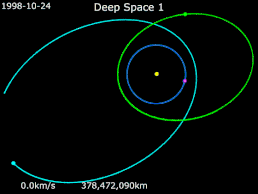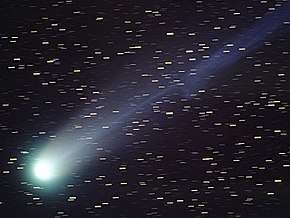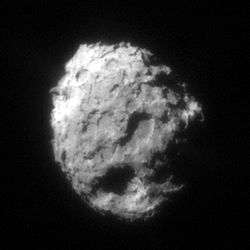19P/Borrelly
Comet Borrelly /bɒˈrɛli/ or Borrelly's Comet (official designation: 19P/Borrelly) is a periodic comet, which was visited by the spacecraft Deep Space 1 in 2001. The comet last came to perihelion (closest approach to the Sun) on May 28, 2015 and will next come to perihelion on February 1, 2022.[2][1] The comet's nucleus, seen in the adjacent image, is particularly notable for being shaped like a bowling pin.
 | |
| Discovery | |
|---|---|
| Discovered by | Alphonse Borrelly |
| Discovery date | December 28, 1904 |
| Designations | |
| 1905 II; 1911 VIII; 1918 IV; 1925 VIII; 1932 IV; 1953 IV; 1960 V; 1967 VIII; 1974 VII; 1981 IV; 1987 XXXIII; 1994 XXX | |
| Orbital characteristics | |
| Epoch September 8, 2001 (JD 2452160.5) | |
| Aphelion | 5.83 AU |
| Perihelion | 1.35 AU (February 1, 2022)[1][2] |
| 3.59 AU | |
| Eccentricity | 0.624 |
| 6.8 a | |
| Inclination | 30.3° |
| February 1, 2022[1][2] | |
| Earth MOID | 0.37 AU (55 million km) |
| Physical characteristics | |
| Dimensions | 8×4×4 km[3] |
Mean radius | 2.4 km[4] |
| Mass | 2×1013 kg[5] |
Mean density | 0.3 g/cm³[6] |
| Albedo | Albedo: 0.03[7] |
Discovery
The comet was discovered by Alphonse Borrelly during a routine search for comets at Marseilles, France on December 28, 1904.
Deep Space 1 flyby

Deep Space 1 · 9969 Braille · Earth · 19P/Borrelly
On September 21, 2001 the spacecraft Deep Space 1, which was launched to test new equipment in space, performed a flyby of Borrelly. It was steered toward the comet during the extended mission of the craft, and presented an unexpected bonus for the mission scientists. Despite the failure of a system that helped determine its orientation, Deep Space 1 managed to send back to Earth what were, at the time, the best images and other science data from a comet.

References
- MPC
- Seiichi Yoshida (2014-08-10). "19P/Borrelly". Seiichi Yoshida's Comet Catalog. Retrieved 2014-10-29.
- Weaver, H. A.; Stern, S.A.; Parker, J. Wm. (2003). "Hubble Space Telescope STIS Observations of Comet 19P/BORRELLY during the Deep Space 1 Encounter". The American Astronomical Society. 126 (1): 444–451. Bibcode:2003AJ....126..444W. doi:10.1086/375752. Retrieved 2008-12-16.
- "19P/Borrelly: Facts & Figures". Archived from the original on 2014-08-09. Retrieved 2014-08-08.
- Using the volume of an ellipsoid of 8x4x4km * a rubble pile density of 0.3 g/cm³ yields a mass (m=d*v) of 2.0E+13 kg.
- D. T. Britt; G. J. Consol-magno SJ; W. J. Merline (2006). "Small Body Density and Porosity: New Data, New Insights" (PDF). Lunar and Planetary Science XXXVII. Archived (PDF) from the original on 17 December 2008. Retrieved 2008-12-16.
- Robert Roy Britt (2001-11-29). "Comet Borrelly Puzzle: Darkest Object in the Solar System". Space.com. Archived from the original on 22 January 2009. Retrieved 2008-12-16.
External links
- http://jcometobs.web.fc2.com/pcmtn/0019p.htm
- 19P – Gary W. Kronk's Cometography
- Elements and Ephemeris for 19P/Borrelly – Minor Planet Center
| Numbered comets | ||
|---|---|---|
| Previous 18D/Perrine–Mrkos |
19P/Borrelly | Next 20D/Westphal |

